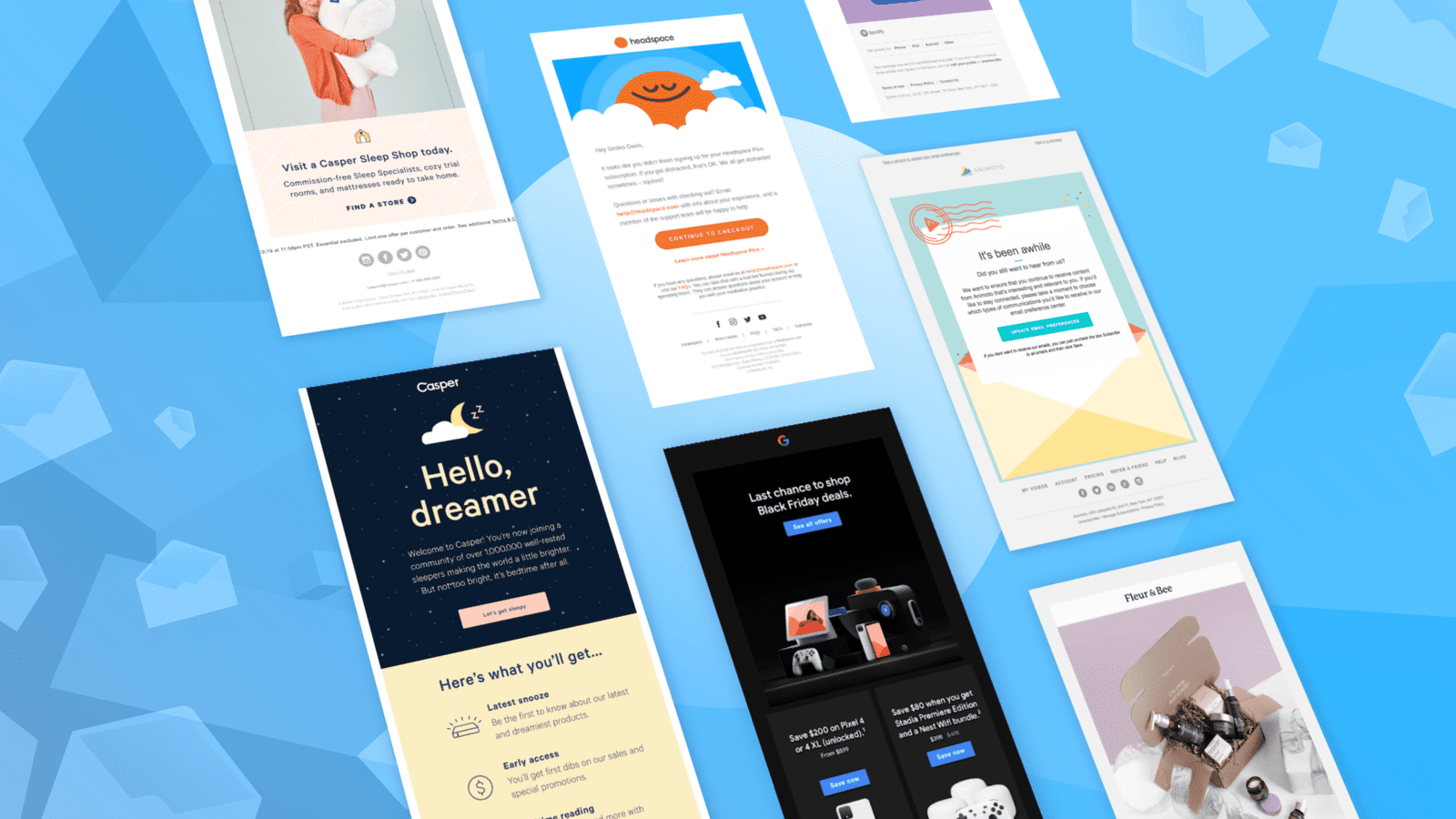Everyone believes they’re a unique individual. And that’s true! As Dr. Seuss would say, there is no one alive who is you-er than you.
But we’re all pretty much the same when it comes to how we engage with information. The brain is a remarkably efficient machine, constantly automating processes and prioritizing important data. That’s why you can navigate between home and the office without thinking once about your route, and why you can always hear your name over the buzz of conversation.
The same principles apply to the inbox. When confronted with a daily slew of newsletters and updates, we tend to immediately tune out anything that fails to capture our attention. That’s why a little insight about human behavior goes a long way when it comes to increasing your engagement rate. Beyond the importance of thoughtful design, the content and timing of your emails makes a big difference when it comes to conversion.
Below, we’ve broken down the behavioral best practices that yield higher email engagement rates.
1. Introduce yourself
According to Campaign Monitor, the most common reason that people ignore an email in their inbox is because they don’t recognize the sender. That’s because humans are hardwired to prefer things that are familiar, a tendency scientists call “the mere exposure effect.” If your customers recognize your emails, they’re more likely to engage with them.
You want to start off on the right foot with your subscribers, which means building trust and familiarity from the first email. Start with a welcome email that introduces your brand and explains what users can expect from you. Here’s a standout example from Casper, clearly outlining the purpose and value of their emails.
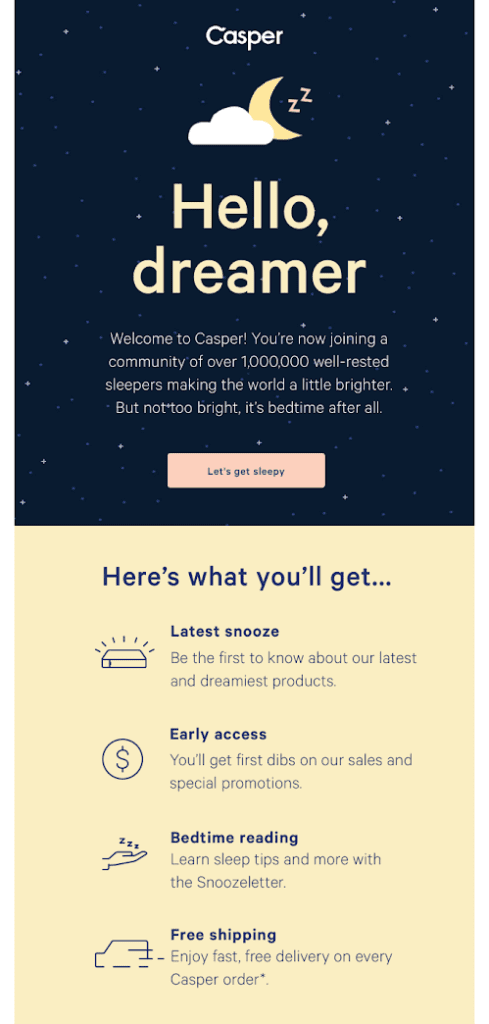
Keep your emails on-brand so that they’re instantly recognizable, from the sender name to the design elements of each communication. Using templates for each type of email campaign makes this simple.
2. Fine-tune your email frequency
Not too much, not too little— the frequency of your emails needs to be just right.
How often have you unsubscribed from a newsletter because the daily emails cluttered up your inbox? It’s not just me: 46% of people have hit unsubscribe because of too many emails. Worse, sending too frequently can lead irritated subscribers to flag your messages as spam, harming your sender reputation.
But too infrequent isn’t good either, because users don’t want to read emails from brands they can’t remember. When COVID-19 hit, my inbox was suddenly full of unknown companies, offering me their support during these difficult times. It’s like when Facebook reminds you that today is your college roommate’s brother’s birthday. Who?
So how do you strike the balance between being a forgettable email acquaintance and a too-frequent inbox visitor? Well, you could just ask: let your subscribers choose the frequency of emails.
You can also look to your campaign analytics for insights. According to GetResponse, marketers who send just one email per week get the highest engagement. But this will vary by audience, so pay attention to what works for you. Try adding or subtracting an email from your typical weekly schedule, and see how it affects click rates and conversions.
3. Keep your lists clean
When it comes to subscriber lists, bigger is not always better.
Take stock of your contacts regularly, and remove inactive subscribers. Your subscriber database should not operate like Hotel California: let people go if they’re not interested anymore.
This will immediately result in a gratifying increase in your engagement metrics, but it’s not just good for an ego boost. Remember your sender reputation? A high bounce rate due to invalid email addresses clogging up your subscriber lists will also damage it. Then even your most devoted subscribers will be less likely to receive your messages.
You can also reach out to your unengaged subscribers before removing them from your lists. Sending a re-engagement campaign, like this example from Animoto, may reignite the interest of some of your lapsed subscribers. And if it doesn’t, you can feel good about clearing them out of your database.
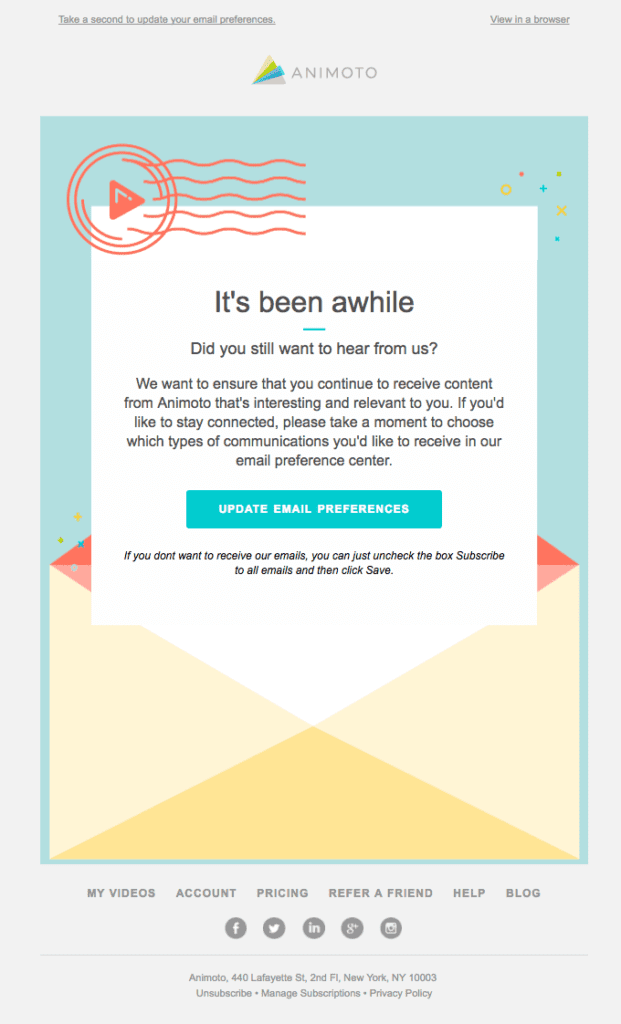
4. Time it perfectly
What’s the best time to send an email? For maximum engagement, hit send at 9:53AM on a Thursday.
Just kidding! Unfortunately, there’s no universal answer here. GetResponse analyzed four billion emails and observed peaks in engagement at 10AM, 1PM and 6PM. They found weekdays were better than weekends, and earlier in the week (Monday and Tuesday) was slightly better than later. But overall, differences were small.
That doesn’t mean that the timing of your emails doesn’t matter— it can actually make a significant difference in engagement. But the key is understanding your audience. The demographics and interests of your customers will all affect their email behavior and preferences.
To identify your optimal send time, you’ll want to do some A/B testing. A/B testing is a great way to refine any aspect of your email strategy, and it’s perfect for honing in on the best time to send your emails. Pay attention to the KPIs based on your email marketing goals here: if you’re trying to boost web traffic, focus on the relative click-through rates. If your goal is driving sales, you want to zero in on conversions.
You might find the best send time depends on the purpose of the email campaign. Maybe people are happier to open your marketing emails on weekday mornings, when they’re putting off their work inbox, but they’re more likely to actually make a purchase late at night. The only way to find out is to experiment!
5. Optimize your subject lines
They say you shouldn’t judge a book by its cover, but we all do it. That’s why I will never purchase an otherwise-great novel with a tacky “Now a major motion picture!” cover.
Likewise, we judge emails by their subject lines. First impressions count, and your email’s appeal hinges on that one little line of text.
Mailchimp analyzed 24 billion emails to reverse-engineer the perfect subject line. Overall, they found that urgency and gratitude boosted engagement, which makes sense. People are more likely to open a positive, affirming email (“Thank you for your support!”) or one that promises important info. Mailchimp also found personalization made an impact (more on that below).
Another interesting finding was that a single word often made a difference— whether that’s changing “Important Announcement” to “Big Announcement.” But there was no formula for identifying the higher-performing words. The only way to find your magic words is to (surprise, surprise) do some more A/B testing.
Your subject lines should also tantalize, but not mislead. Don’t use the subject line “An amazing deal is just one click away…” if there is no deal in the email. A deceptive subject line might get people opening your email, but they’ll delete it if the content doesn’t live up to the promise. And that’s also why you should evaluate the impact of your subject lines based on conversions and click-throughs, not open rates.
6. Create urgency
FOMO may have only been added to the dictionary in 2016, but the emotion is ancient and universal. Mailchimp found that subject lines including the words “urgent,” “breaking,” or “important” all had higher than average open rates.
That’s because urgency spurs action. If I see something on sale, I’m tempted to buy it. But if it’s on sale for one day only, that’s much harder to resist. It’s not just me: 60% of Millennials have reported making a purchase due to FOMO.
Encourage your subscribers to act now with a last-chance promotion, like this one from Google.
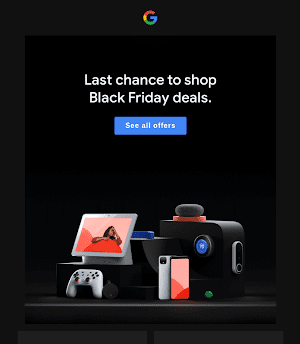
You can also entice customers with exclusive offers and limited-edition products. This email from Polaroid is a perfect example:
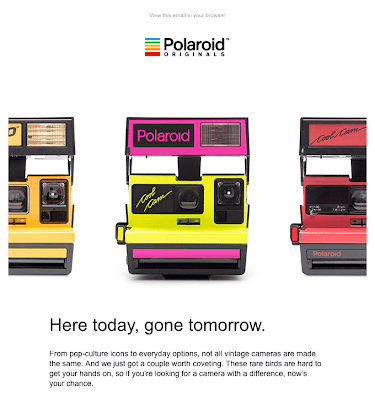
And of course, there are abandoned cart emails. These are an example of highly-effective transactional emails, triggered by customer behavior. In this case, that’s adding something to their shopping cart but not buying it. Or, as in this example from Headspace, exiting before finishing a sign-up or subscription process:
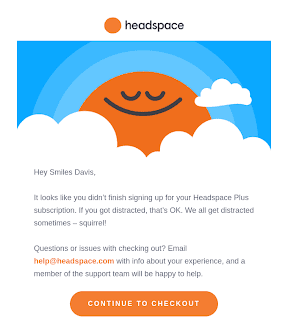
You’ve probably received a fair number of abandoned cart emails. That’s because they really work: over a third of clicks from these emails lead to purchases. After all, no one likes missing out on a good thing.
7. Make it interactive
Are you still sending static email campaigns? It’s time to switch it up! 81% of surveyed marketers agree that interactive content is better at grabbing attention.
Think of it this way: regular emails are like a monologue, but an interactive email is like a conversation. The user gets to be active, rather than passive, which keeps them interested. And dynamic elements like video are inherently more engaging than static ones. One company found adding videos to their emails increased clicks by 300%. Just keep it short— the average attention span for video is about 60 seconds.
Another simple, dynamic element that can drive sales? A countdown timer. Neuroscience Marketing found that adding a simple countdown showing the amount of time left to order for next-day delivery boosted sales by 9%. Countdown timers increase the sense of urgency and scarcity. And as you’ve just learned, FOMO is a powerful motivator.
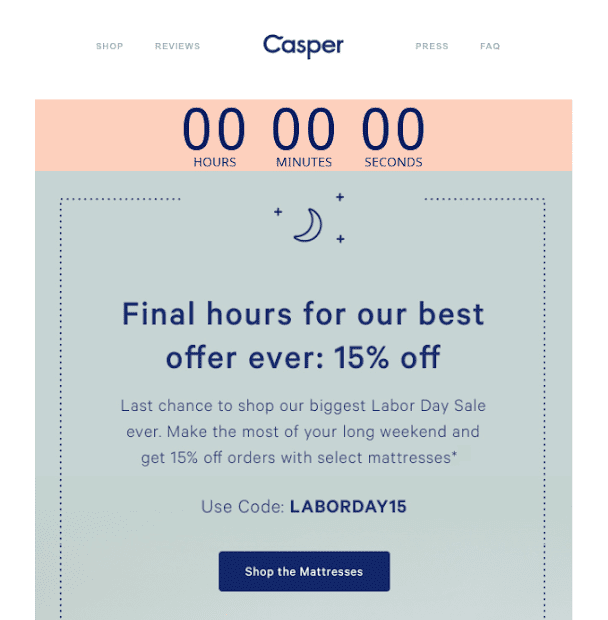
If you’re intimidated by interactive email, don’t be. Using an email builder makes it simple. Rather than coding each interactive element yourself, you can just drag-and-drop dynamic elements like carousels, videos, forms and more.
8. Use incentives strategically
I confess I’ve signed up to many, many email lists to secure the new-subscriber promo code. Then, once I’ve used it, I’ve promptly unsubscribed. Thanks for the 25% discount! Goodbye forever!
Lead magnets like one-time discount codes and downloadable e-books do get people to sign up and engage with that first email. But if you don’t continue to offer your subscribers value, they’ll quickly lose interest.
You want to keep them coming back— so consider how incentives can generate long-term engagement. The aptly-named incentive theory of motivation finds that positive reinforcement, though rewards and benefits, keeps people motivated.
That means you need to offer subscriber ongoing benefits, not one-time offers. Send content that’s useful, like gift recommendations (with helpful free shipping, like Fleur + Bee’s offer below). Think beyond the lead and build loyalty for the long haul.
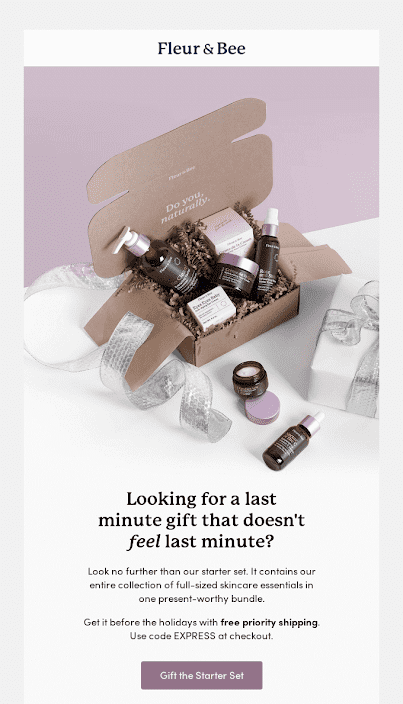
You can also offer subscribers exclusive offers and previews. Aritzia sends their subscribers previews of each new collection, allowing them to view products before other shoppers. It’s a great way to keep your customers excited about each new email.

9. Create meaningful segments
Segmenting your subscribers will help you send better emails that people want to click on. In fact, Mailchimp found that segmented campaigns have click rates that are 101% higher than non-segmented campaigns.
There are plenty of ways to divide your lists. We’ve already mentioned one: segmenting by email frequency. Your superfans might want to hear from you three times a week, while most subscribers prefer a single email. You might even have another segment that only receives your most important updates.
Segmenting by interest is another way to boost engagement. You can gather data on customer preferences during the sign-up process, as part of your onboarding campaign, or based on their purchases or behavior.
You can also segment your list by location, which is useful for businesses who do in-person sales or events, and for ensuring every email arrives at the optimal time. In fact, there are endless ways to segment your list— but you can also go a step further, with personalization.
10. Get personal
Segmentation and personalization have a lot in common: they’re both ways of tailoring your emails to specific users. But while segments target groups of users, personalization can go deeper, addressing each user individually.
This is incredibly effective. Did you know personalized subject lines (“Hi, Dan!” instead of “Hi, friend!”) can increase your open rates by 26%? That’s because our brains are activated by the sight of our own name.
Of course, you can’t stop at the subject line and first name: the content inside the email needs to be relevant too. Otherwise it feels like a Valentine’s Day card from your dentist: generic and disappointing.
Showing customers items they’ve already looked at, asking for a review of a recent purchase, or offering recommendations based on past shopping habits are all effective personalization tactics. Or you could take a page from Spotify, which has built a dedicated following for their personalized annual listening summaries.
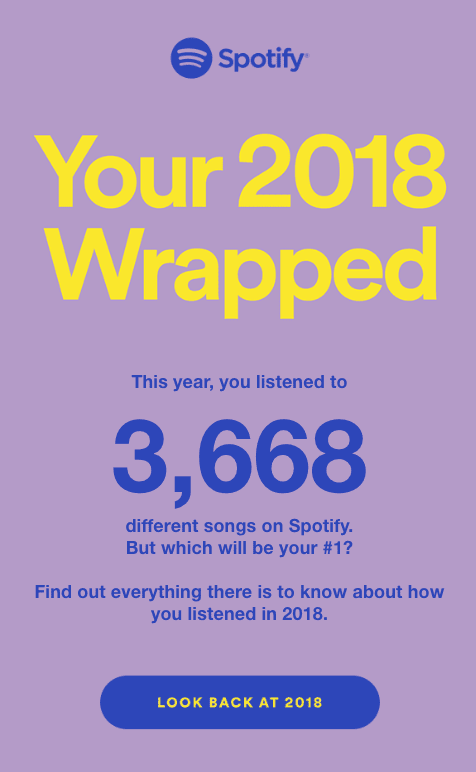
If personalization is so great, then why is your inbox full of generic email? It can be hard to pull off if you’re relying on coding each email from scratch, or if you’re keeping all your customer data in an inaccessible format. Using an email creation platform like Dyspatch can help: it integrates seamlessly with your customer data platform. Modular, customizable content blocks make it easy to craft highly-personalized, dynamic emails.
Sign up today for a free trial of Dyspatch to create and send engaging emails that your subscribers will actually want to read.
